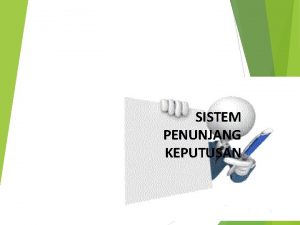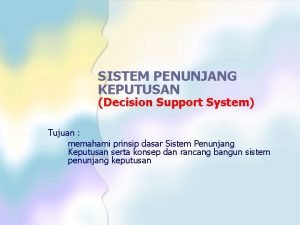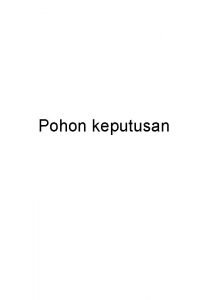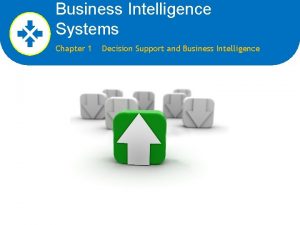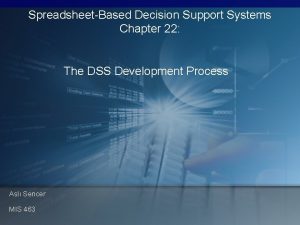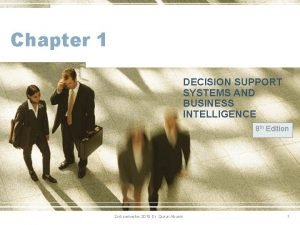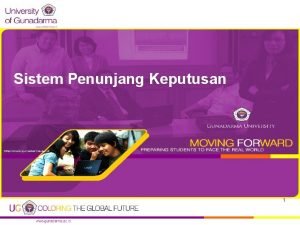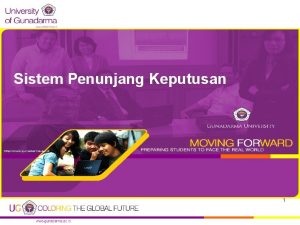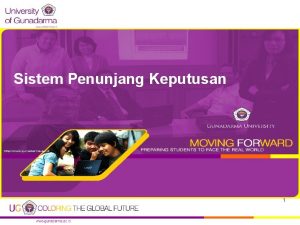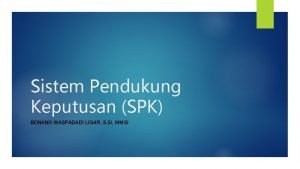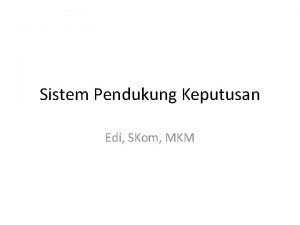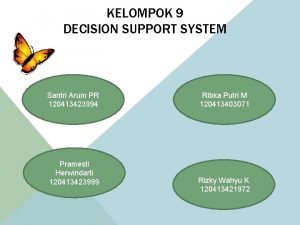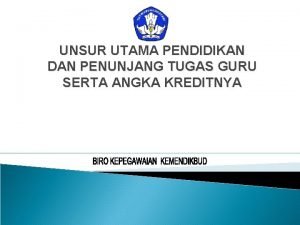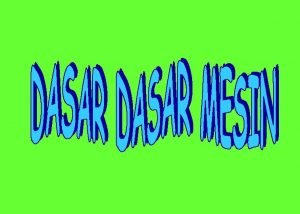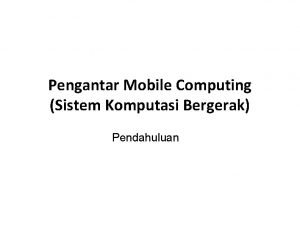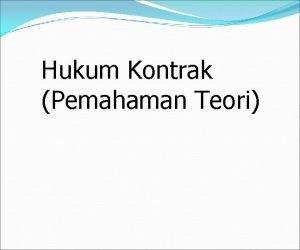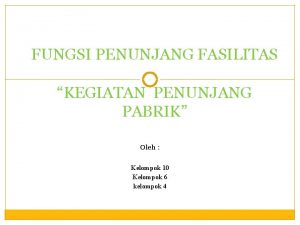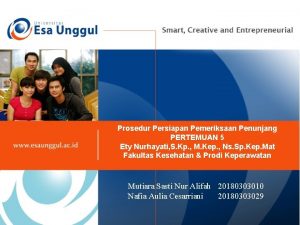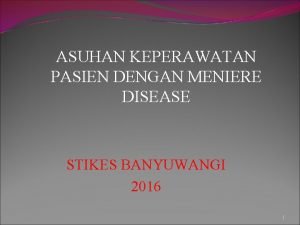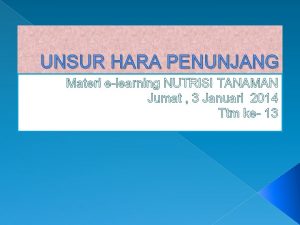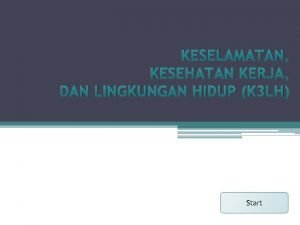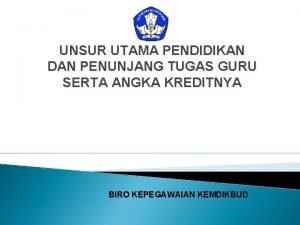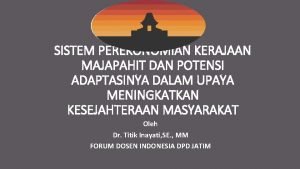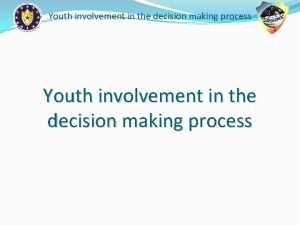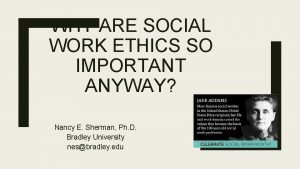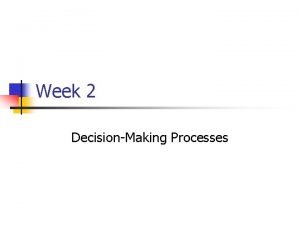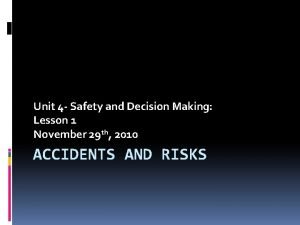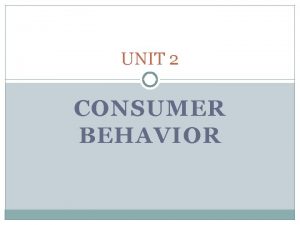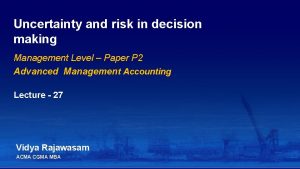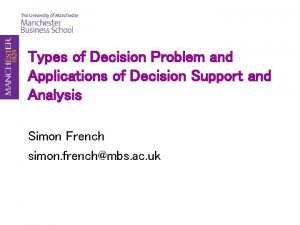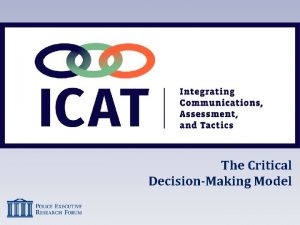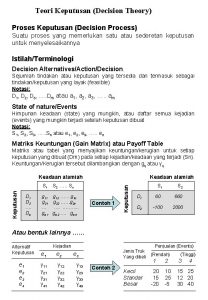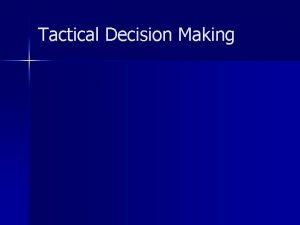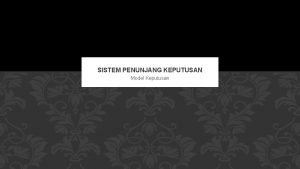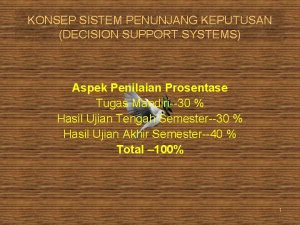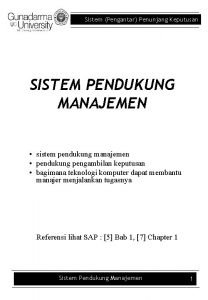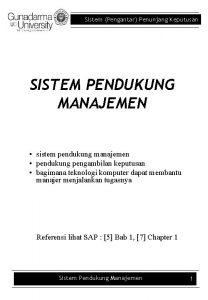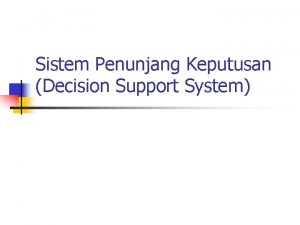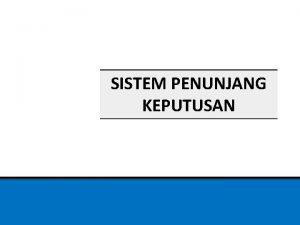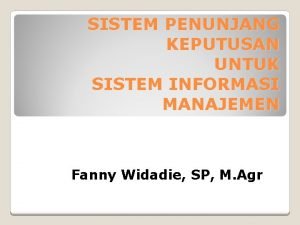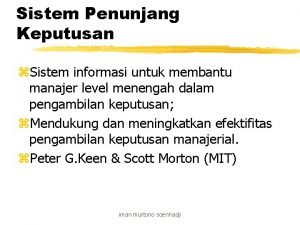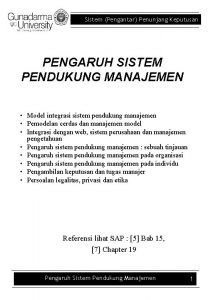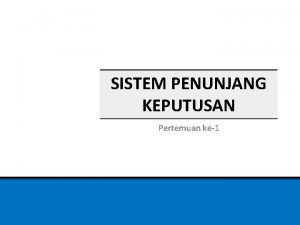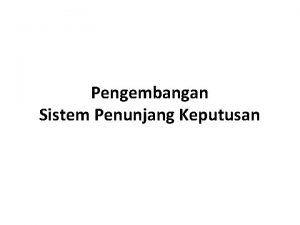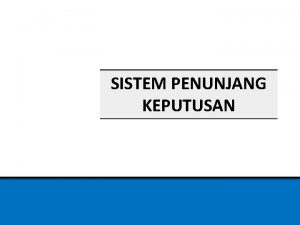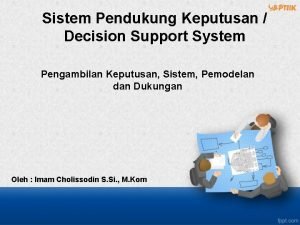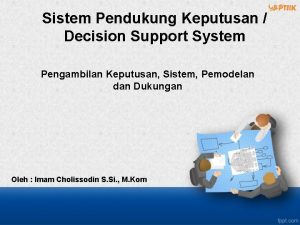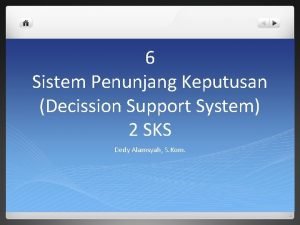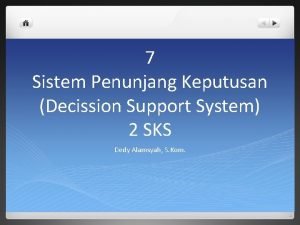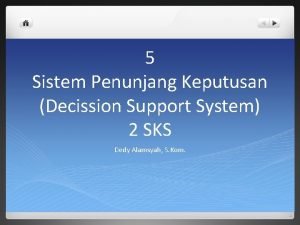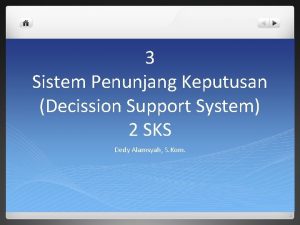Decision Support Systems Sistem Penunjang Keputusan Decision Making




















































- Slides: 52

Decision Support Systems Sistem Penunjang Keputusan

Decision Making • Whom do we intend to support? • In what capacity? • In what context?

Decision Making u Managerial Activity (Chapter 1) • Objectives -- After studying this chapter, you should be able to – Effectively converse with managers about what they do and understand what you would do as a manager. – Describe the general nature of organizations that you may someday manage. – Cite the four major resources of organizations and explain what managers do with them.

Decision Making – Identify the various functions or roles that describe the work a manager performs. – Explain relationships that exist among management, knowledge, decision making, and technology. • Relevance – DSS as element of managerial activity – Managerial activity as guiding metaphor for DSS designs

Decision Making • What does a manager do? – To have impact on managerial practice, we must answer various questions (Mintzberg 1980) • What kinds of activities does manager perform? • What kinds of information does manager process? • What are distinguishing characteristics of managerial work? • What is of interest about media used, activities preferred, flow of activities, use of time, pressures of job, etc. ?

Decision Making • What basic roles can be inferred from study of activities? • What variations exist among managerial jobs and why? • To what extent is management a science and a manager’s work repetitive, systematic, predictable? – More fundamentally, what is it that is managed? • An Organization – small ----- large – private ----- public ----- governmental – informal ----- formal – temporary ----- permanent

Decision Making • But what exactly is an organization? – A system – of resources – structured by – power centers to – achieve some purpose – within some environment (1) (2) (3) (4) (5) (6)

Decision Making • System – open system (J. Miller 1972) • affects and is affected by surroundings – accepts inputs and produces outputs • Resources – three categories (Miner 1978) • monetary, material, human – inputs as resources

Decision Making – difficulties with this view? • I/0 relationships are 1: 1 • Missing resource – fourth type of resource • • existing within an organization (asset) can be input to organization also output by organization Knowledge

Decision Making • Structure – at any moment, resources are configured in some nonrandom manner: current state – some structural aspects are relatively static, while others are very dynamic – roles are an important structuring mechanism (Biddle and Thomas 1966) • division of labor • labor-capital substitution

Decision Making • Power Centers – wielders of authority (i. e. , managers) – a major task of management (Miner 1978) • “attract, select, and allocate resources” (i. e. , structure resources) – differentiate based on scope of authority – different organization designs result from alternative distributions of power

Decision Making • Purpose – managers work to bring system to state consistent with purpose/goals – possibility of dysfunction • Environment – changing state of environment --- change in org. state to maintain consistency with purpose/goals – organization can affect environment

Decision Making – Managerial functions (Fayol 1916) • Planning: establish forecasts; formulate outline of things to be done and methods for execution with respect to organization purpose • Organizing: configuring the organization’s resources (esp. human: selection, role assignment, education, evaluation of managers) • Command: issuing instructions of specific and general natures to cause activities to happen (i. e. , sending directive messages to humans) • Coordination: interrelating/harmonizing activities in the organization • Control: verifying proper implementation of plans

Decision Making • Extensions (Urwick 1943) – Forecasting: separate from planning – Investigation: synonymous with research (resulting in acquisition of knowledge) – Communicating (e. g. , reporting) • Alternative conception (Barnard 1968) – Providing a system of communication by establishing and staffing managerial roles – Securing efforts by eliciting desired role behavior – Formulating purpose by specifying what work to do

Decision Making – Notes: • Functional approach to characterizing what a manager does – based on interpretation of personal experience – suggests “management support systems” – criticized (e. g. , by Mintzberg (1980) as labeling our areas of ignorance, describing vague objectives, indicating what we need to explain – no mention of decision making or knowledge

Decision Making – Managerial roles (Mintzberg 1980) • Derived from empirical studies of managerial work • Ten interrelated roles performed by all managers fall into three categories Interpersonal roles derive from authority, status 1. Figurehead - obliged to perform routine duties of social, ceremonial, or legal nature 2. Leader - motivates/activates subordinates, including staffing, training, promoting, probing 3. Liaison - maintains network of contacts in environment for trading information and services

Decision Making Informational roles derive from access to information that interpersonal roles provide 4. Monitor - seeks and acquires information to have understanding of organization and its environment 5. Disseminator - transmits information (from subordinates, outsiders, self) to others in organization 6. Spokesman - transmits information to outsiders (PR) Decisional roles derive from authority and information 7. Entrepreneur - searches organization and environment for opportunities and initiates/devises controlled change in organization 8. Disturbance Handler - initiates/devises corrective action when org. faces unexpected disturbance

Decision Making 9. Resource Allocator - allocates resources, in effect determining where organization will expend its efforts (i. e. , determining org. strategy) 10. Negotiator - represents organization in negotiations with others Note: Emphasis on communicating, information, decision making

Decision Making • A working perspective – A manager is an entity having the power to structure some monetary, material, human, and knowledge resources existing in an organization, with the intent of pursuing some purpose of the organization with respect to its environment – An organization’s managers transform its resources from one state to another, in the interest of conforming to its purpose within a changing environment

Decision Making – An organization’s managers can acquire resources from the environment and release resources to the environment – All activities of a manager involve • decision making • communication • A manager can make decisions about plans, organization, commands, coordination, control. Similarly, a manager can communicate with respect to each of these. – Both decision making and communication are based on the ability to handle knowledge (acquiring, storing, recalling, using, deriving, distributing)

Decision Making – In communicating, the manager transmits/receives knowledge. The communication process is concerned with message passing and implies the existence of some language – In making a decision, the manager manufactures knowledge: a description of what to do with resources, a description of a future state. The manufacturing process draws on knowledge: descriptions of what is, what is desired, what is expected

Decision Making – How can computers support a manager’s decision making? • implies communication • orientation toward particular kinds of decisions? • different types of support for different decisions, decision makers, decision contexts • need for general understanding of decision making

Decision Making u Decisions (Chapter 2) • Objectives -- After studying this chapter, you should be able to: – Explain what a decision is and what it means to make a decision. – Distinguish among various decision contexts that you might encounter as a manager. – Recognize the different types of decisions that managers make. – Classify a given decision as either structured, semistructured, or unstructured.

Decision Making – Converse about decision support needs and characteristics for various decision contexts and decision types that managers face. • What is a decision? – A choice • about: “course of action” (Simon 1960; Costello & Zalkind 1963; Fishburn 1964; Churchman 1968) “strategy of action” (Fishburn 1964) leading “to a certain desired objective” (Churchman 1968)

Decision Making – A piece of knowledge indicating the nature of an action commitment • Decision may be descriptive knowledge “Spend $10, 000 on advertising in 3 rd quarter” • Decision may be a piece of procedural knowledge “First do A, then do B twice, and if the response is satisfactory, then proceed with C” • Decision making: activity of manufacturing a new piece of knowledge expressing commitment to some course of action – A knowledge-intensive activity – Alters the state of knowledge

Decision Making • Contexts in which decisions are manufactured influence nature of decision making – Management level Anthony taxonomy (Anthony 1965) • A decision is made in the context of – Strategic planning about overall objectives and policies – Management control to assure resources acquired/used in effective/efficient way – Operational control to assure that specific tasks are carried out effectively/efficiently by operating personnel

Decision Making • Forms a continuum – Top ----- Middle ----- Lower Management – Organization ----- Department ----- Line • Support needs can differ depending on the level – Maturity • A decision is made in the context of – Established situation, suggesting considerable knowledge about (e. g. , experience with) the current state of the world and the history of past encounters – Emergent situation, suggesting knowledge scarcity • Continuum

Decision Making – Concurrency • Multiple decisions simultaneously in process – for an individual – for an organization • Coordination of dependencies • Scheduling concurrent manufacturing processes – Organization design • Centralization vs decentralization • Generalists (many roles) vs specialists ( few roles) • Hierarchic vs flat authority structures

Decision Making • Types of Decisions – Influence nature of decision making – Classify in terms of: – Management level • strategic planning vs management control vs operational control – Management function (POCCC) – Functional areas

Decision Making – Structuredness (Simon 1960) • Refers to how routine, repetitive the mfg. process is Structured Unstructured Established Situation Emergent Situation Programmable Decision Creative Decision Situation Fully Understood Situation Unclear Routine One-shot Specialized Mfg. Processes General Processes – Negotiation • Unilateral decisions • Negotiated decisions

Decision Making u Decision Maker (Chapter 3) • Objectives -- After studying this chapter, you should be able to: – Compare and contrast four major kinds of decision makers that you are likely to encounter in an organization. – Describe the phases you would go through in a decision-making process. – Explain the relationship between problem solving and decision making.

Decision Making – Identify common strategies that are used in guiding decision-making processing. – Describe limitations that managers encounter in making decisions. – Discuss decision support needs and characteristics for various kinds of decision makers and decisionmaking strategies. • What is the nature of the entity that manufactures a decision?

Decision Making • This influences the manufacturing process • Individual – Person • May vary in terms of training, experience, cognitive styles, intelligence, knowledge (Miner 1978) • Common traits – Can accept messages stated in some language – Possesses a reservoir of knowledge

Decision Making – Computer • Factory automation • Robotics • Structured, Programmable Decisions in established, operational control contexts – Distributed, Multiperson • Decision made by group/committee – No formal structure of authority – Effects (Miner 1978; Steiner and Miner 1977) - inhibitory effect on production of ideas in face-to-face meetings

Decision Making - brings new knowledge, viewpoints to bear - often takes longer - risky shift (tend to take greater risks) - group think (tend over time to develop strong norms that may prevent paying adequate attention to realities - blind spots) – Brainstorming (Summers & White 1976) - members produce ideas, circulate them, without criticism vs usual mix of production and critics

Decision Making - perception that expert present has inhibitory effect, esp. if all are conceived as experts (Collaros and Anderson 1969) – may be better for some types of decisions than for others • Decision shared with subordinates (Heller 1976) – participants differ in terms of authority, specialties – facilitated by following conditions - high quality decision needed - manager lacks needed knowledge - decision is unstructured

Decision Making - implementation of decision may require subordinate acceptance - there is some question about securing that acceptance - subordinate commitment to organization’s goals - minimal conflict among subordinates – pattern/mechanism of this distribution decision making depends on organization design - hierarchic - market

Decision Making u Decision Process (Chapter 3) - to understand decision support possibilities, we need a conception of the process that results in a decision - we then ask what aspects of decision making are amendable to computer-based support

Decision Making • Phases (Simon 1960) – Intelligence • collecting, organizing knowledge • alertness to occasions for decision – Design • identification, examination of possible courses of action • evaluation of expected outcomes for these – Choice • applies authority to make selection, in face of internal/external pressures

Decision Making – May not occur in strict, uninterrupted sequence • concurrency of phases • loops • each phase may initiate subactivities

Decision Making • Problem solving – Activity directed toward satisfying some sensed need (Costello & Zalkind 1963) – “emphasizes thought process that precedes terminal choice” (Ebert & Mitchell 1975) – Making a decision involves the solving of problems • what problems? • in what sequence? For structured decisions, answers well-known For unstructured decisions, they are not -- require exploration, ingenuity, dead ends

Decision Making • Decision-Making Strategy decision-making process colored by strategy used to choose – Optimizing: select course of action with highest payoff/utility • must estimate costs/benefits of every viable alternative • very costly in time, effort, money to collect/examine volumes of knowledge • no way to adequately combine all factors into a utility measure (Miller and Starr 1969) • more prescriptive than descriptive

Decision Making – Satisficing: select course of action “good enough” to meet minimal set of requirements (Simon 1976) • all alternatives are not considered • consistent with limited ability to foresee consequences and limited time, effort, money to make decision • alternatives considered sequentially • differences from optimizing (can be hybrids) – S: small set of requirements, all of which met O: possibly large set of requirements, “best” set chosen

Decision Making – S: sequentially test each alternative as generated O: consider as many “good” alternatives as possible – S: test alternative in a haphazard order O: repeatedly reexamine “best” alternatives – S: test is not a cut off point and equal importance O: additive, assessment of utility – Elimination-by-aspects (Tversky 1972) • narrowing process, eliminating alternatives that fail with respect to 1 aspect, then another, etc. • if run out of aspects, introduce another

Decision Making • could run out of alternatives, or eliminate one that is “overall” superior to others in all but a single aspect • variants - ascribe weights to aspects – Incrementalism (Lindblom 1959, 1965) • “muddling through” or “putting out fires” • successive comparisons of alternatives to current course, to find ways of removing shortcomings of present approach – Mixed scanning (Etzioni 1967) • scanning: search, collection, processing, evaluating, weighing of information • importance of decision determines degree of scanning and choice approach

Decision Making • for major decisions – list alternatives – briefly consider all, rejecting those with “crippling objection” – iterate with the remainder in greater detail until one alternative remains • for minor ensuing decisions – incremental satisficing

Decision Making • Knowledge Management Perspective May be structured --- unstructured May involve intelligence, design, choice May entail problem reduction May employ any of several decision strategies But in all cases, knowledge is raw material, work in process, finished good of decision making.

Decision Making As raw material, knowledge is either possessed by decision maker or invoked by decision maker Problems faced in making a decision involve the processing knowledge • Need for Decision Support – Cognitive limits • human capacity for processing contents of immediate memory limited to about 7 variables

Decision Making • long term memory capacity apparently small relative to growing volumes of relevant knowledge • problems of forgetting, erroneous recall • information inundation can be as debilitating as information scarcity – stress – error – ignoring too much • problems of erroneous, infeasible processing

Decision Support – Economic limits • humans are expensive • increasing their number of compensate for cognitive limits, can become economically prohibitive – Temporal limits • decision may be required in a time frame that puts severe pressure on a decision maker • given limits in human processing speed, the decision maker may be forced to use unwanted strategy

Decision Support – Competitive strategy implications • Nature of support – Systems that solve problems involved in decision making – Systems that facilitate/extend knowledge management capabilities – Systems that coordinate distributed decision making – Systems that offer advice, expectations, facts, analyses, etc. – Above are interactive in nature

Decision Making – May range from supporting structured to unstructured decision processes – May play a stimulative role • Source of support – Human – Computer (metaphor)
 Pengertian sistem pendukung keputusan
Pengertian sistem pendukung keputusan Tujuan dari sistem penunjang keputusan
Tujuan dari sistem penunjang keputusan Decision support systems and intelligent systems
Decision support systems and intelligent systems Pohon keputusan
Pohon keputusan Chapter 2 economic systems and decision making answer key
Chapter 2 economic systems and decision making answer key Chapter 2 economic systems and decision making
Chapter 2 economic systems and decision making How do information systems aid in decision making
How do information systems aid in decision making Chapter 2 economic systems and decision making answer key
Chapter 2 economic systems and decision making answer key Decision support and business intelligence systems
Decision support and business intelligence systems Developing spreadsheet-based decision support systems
Developing spreadsheet-based decision support systems What is decision support system in business intelligence
What is decision support system in business intelligence Expert system in dss
Expert system in dss Objectives of decision making
Objectives of decision making Dividend decision in financial management
Dividend decision in financial management Arsitektur sistem pendukung keputusan
Arsitektur sistem pendukung keputusan Arsitektur spk
Arsitektur spk Arsitektur sistem pendukung keputusan
Arsitektur sistem pendukung keputusan Contoh sistem pendukung keputusan
Contoh sistem pendukung keputusan Pengertian spk
Pengertian spk Sistem pendukung keputusan
Sistem pendukung keputusan Contoh kegiatan penunjang guru
Contoh kegiatan penunjang guru Tiga faktor penting penunjang kerja mesin yaitu adalah
Tiga faktor penting penunjang kerja mesin yaitu adalah Teknologi penunjang mobile komputing..
Teknologi penunjang mobile komputing.. Elemen penunjang kontrak
Elemen penunjang kontrak Pengertian fasilitas penunjang
Pengertian fasilitas penunjang Prosedur persiapan pemeriksaan penunjang
Prosedur persiapan pemeriksaan penunjang Trias meniere disease
Trias meniere disease Unsur hara penunjang
Unsur hara penunjang Unsur-unsur penunjang kesehatan rohani di tempat kerja
Unsur-unsur penunjang kesehatan rohani di tempat kerja Angka kredit anggota pgri
Angka kredit anggota pgri Sistem ekonomi majapahit
Sistem ekonomi majapahit Derajat kremer pada bayi
Derajat kremer pada bayi Bagian penunjang ptk
Bagian penunjang ptk Making inferences
Making inferences War making and state making as organized crime summary
War making and state making as organized crime summary Grammatical signals
Grammatical signals Involvement decision making
Involvement decision making Nasw essential steps for ethical problem solving
Nasw essential steps for ethical problem solving Systematic decision making process
Systematic decision making process What doing our country
What doing our country Mamdm
Mamdm Using recursion in models and decision making sheet 3
Using recursion in models and decision making sheet 3 What is this image
What is this image Unit 4 lesson 1 decision making
Unit 4 lesson 1 decision making Decision making to improve marketing performance
Decision making to improve marketing performance Types of decision making
Types of decision making External factors higher business
External factors higher business Contribution payoff table
Contribution payoff table Types of decision making
Types of decision making Functions of marketing research
Functions of marketing research Critical decision making model police
Critical decision making model police Contoh soal pohon keputusan dan jawabannya
Contoh soal pohon keputusan dan jawabannya Tactical decision making adalah
Tactical decision making adalah
